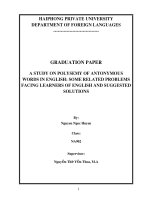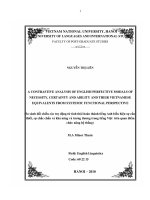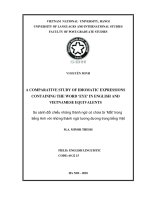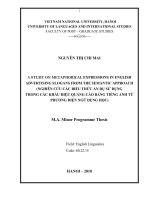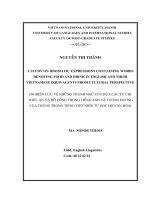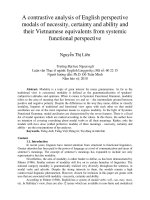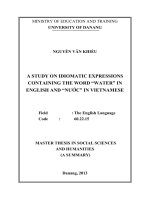A study on idiomatic expressions containing words denoting food and drink in English and their Vietnamese equivalents from Cultural Perspective
Bạn đang xem bản rút gọn của tài liệu. Xem và tải ngay bản đầy đủ của tài liệu tại đây (1.48 MB, 74 trang )
VIETNAM NATIONAL UNIVERSITY, HANOI
UNIVERSITY OF LANGUAGES AND INTERNATIONAL STUDIES
FACULTY OF POST-GRADUATE STUDIES
NGUYÊ
̃
N THI
̣
THA
̀
NH
A STUDY ON IDIOMATIC EXPRESSIONS CONTAINING WORDS
DENOTING FOOD AND DRINK IN ENGLISH AND THEIR
VIETNAMESE EQUIVALENTS FROM CULTURAL PERSPECTIVE
(
)
MA. MINOR THESIS
Field: English Linguistics
Code: 60 22 02 01
Hanoi – 2014
VIETNAM NATIONAL UNIVERSITY, HANOI
UNIVERSITY OF LANGUAGES AND INTERNATIONAL STUDIES
FACULTY OF POST-GRADUATE STUDIES
NGUYÊ
̃
N THI
̣
THA
̀
NH
A STUDY ON IDIOMATIC EXPRESSIONS CONTAINING WORDS
DENOTING FOOD AND DRINK IN ENGLISH AND THEIR
VIETNAMESE EQUIVALENTS FROM CULTURAL PERSPECTIVE
(
)
MA. MINOR THESIS
Field: English Linguistics
Code: 60 22 02 01
Supervisor: Assoc. Prof., Dr. Nguyê
̃
n Xuân Thơm
Hanoi – 2014
i
DECLARATION
I certify that the content of this thesis is the result of my own work and that all the
material and sources collected in preparing this study have been identified and
acknowledged. The thesis has not, wholly or in part, been submitted for any degree
to any other universities or institutions or for any other purposes.
ii
ACKNOWLEDGEMENTS
On the completion of this thesis, I am grateful to many people.
First and foremost, I would like to express my deep gratitude to my supervisor,
Assoc. Prof. Dr. Nguyen Xuan Thom for his enthusiastic guidance and valuable
advice and help, without which, this thesis could not be completed.
I also wish to thank all my lecturers of Post Graduate Department, College of
Foreign Languages, Vietnam National University for their helpful instruction during
my whole course of studying.
In addition, I owe a great debt of gratitude to my family, friends and colleagues,
whose encouragement and assistance play an important part in my doing this thesis.
Finally, I am all too aware that despite all the helpful advice and assistance, the
project is far from perfect. Therefore, I have sole and full responsibility for any
inadequacies and shortcomings that the thesis may be considered to have.
Hanoi, October 2013
Nguy
iii
ABSTRACT
One of the most effective and colourful ways to transfer culture is the use of idioms
which, however, causes many troubles for English learners because of their
confusing meanings. To help learners have a better understanding of idioms,
idiomatic expressions containing words denoting food and drink in English and
languages are analyzed and compared in terms of their syntactic, semantic,
pragmatic and cultural features. The equivalence those idioms of the two languages
is also analyzed. On this basis, it also offers some educational implications for
English teachers and learners to make their teaching and learning more effective.
iv
TABLE OF CONTENTS
Page
ACKNOWLEDGEMENT ii
ABSTRACT iii
PART I: INTRODUCTION
1. Rationale to the study 1
2. Research aims and research questions 1
3. Objectives of the research 2
4. Scope of the research 2
5. Methods of the study 3
6. Significance of the research 4
7. Design of the research 4
PART II: DEVELOPMENT
Chapter I: Literature Review 5
Chapter II: Theoretical background 6
2.1. Overview of Idioms 6
2.1.1. Definition of idioms 6
2.1.2. Typical features of idioms 7
2.1.3. Idioms and other similar language units 9
2.2. The relationship of Language and Culture 12
2.2.1. Concept of Culture 12
2.2.2.The inseparable Relationship between Language and Culture 12
2.2.3. The Relationship between Idioms and Culture 12
Chapter III: METHODOLOGY AND PROCEDURE 14
3.1. Research design 14
3.2. Research methodology 14
3.3. Data collection 14
a. What is food? 14
v
b. What is drink? 16
c. Choosing idioms containing food and drink 16
3.4. Data analysis 16
3.5. Reliability and validity 17
Chapter IV: FINDINGS AND DISCUSSION 17
4.1. Syntactic features of idioms containing food and drink in English and
Vietnamese 17
4.1.1. Phrase Structures 17
4.1.2. Sentence Structures 20
4.2. Semantic features of idioms containing food and drink in English and
Vietnamese 21
4.2.1. Idioms having human implications 21
4.2.2. Idioms having non-human implications 25
4.3. Similarities and differences in syntactic and semantic features of idioms
containing food and drink in English and Vietnamese 26
4.3.1. Similarities 27
4.3.2. Differences 28
4.4. The equivalence of the English and Vietnamese idioms containing food
and drink 31
4.4.1. Idiomatic equivalence 31
4.4.2. Conceptual equivalence 32
4.4.3. Lexical equivalence 33
4.4.4. Semantic and pragmatic equivalence 37
4.5. Cultural characteristics of English and Vietnamese idioms containing
food and drink 37
4.6. Implications for teaching and learning idioms containing food and drink39
PART III: CONCLUSION
1. Conclusion 40
vi
2. Limitations of the thesis and further study 40
3. Suggestions for further study 41
REFERENCES 42
APPENDIXES I
1
PART I: INTRODUCTION
1. Rationale to the study
Mastering a foreign language is a strong desire of all learners. However, it is
not an easy task because of many obstacles that learners face during their learning.
Moreover, their final target of learning a foreign language is the ability to
communicate. A successful communication can only be reached when both the
speakers and the listeners have a common understanding of each other. However,
the differences in many aspects of the languages and cultures cause various
problems for learners in the process of mastering a foreign language.
One of the most effective and colourful ways to transfer culture is the use of
idioms. Because idioms imply culture, we cannot understand idioms correctly
without the cultural context. Besides, according to Cambridge International
also suggest a particular attitude of the person using them, for example disapproval,
interesting English aspects but it has never been easy to learn as well.
Thus, a good understanding of idioms is the key for learners to know more
about the target language as well as its culture and to avoid culture shocks during
communication.
Making comparisons between English idioms and Vietnamese ones can help
Vietnamese learners comprehend the similarities and differences of the two
languages and cultures, which in turn help them improve their English.
Because of the reasons above, I have wished to conduct some studies on
English idioms and Vietnamese equivalent ones. However, due to the limitation of
the graduation I would like to focus on English idioms
containing food and drink and their equivalents in Vietnamese which have attracted
me most for a long time in view of their variety in English idiom treasure.
2. Research aims and research questions
2
This research has four main aims as the followings:
1. To investigate syntactic and semantic features of English and Vietnamese
idioms related to food and drink, from which explore the cultural values underlying
the literal words.
2. To find out the similarities and differences in the cultures of the two
countries which are reflected through their idioms containing food and drink.
3. To equip both those learning English and those learning Vietnamese as
their foreign language with rich knowledge on both English and Vietnamese idioms
in general and on food and drink in particular. Moreover, to help teachers, learners
and translators avoid difficulties in translating English idioms into Vietnamese and
vice versa.
4. To supply some suggested implications for teaching and learning method,
which contribute to improve ability of using English idioms in general, idioms
related to food and drink in particular.
To achieve the above aims, the following research questions are put forward:
1. What syntactic and semantic features are reflected in the food and drink
idioms in both English and Vietnamese?
2. What are the similarities and differences between Vietnamese and English
cultures through idioms related to food and drink? What factors lead to such
differences?
3. Objectives of the research
My study is carried out with the aim to help Vietnamese learners have a
better understanding of English and Vietnamese idioms related to food and drink,
which would encourage them to use idioms more confidently not only in receptive
skills like listening and reading but also on productive skills like speaking and
writing and avoid communication breakdown.
4. Scope of the research
I have found idioms such an interesting English aspect that I decide to
choose them as my thesis topic. However, due to the limited time and knowledge, I
3
just focus on a small part of English idioms,
containing words denoting food and drink in English and their Vietnamese
idioms containing food
and drinkfor short.
Food and drink play a very important role in many cultures including English
culture and Vietnamese culture. Idioms containing food and drink account for a
considerable large portion of idioms in English as well as in Vietnamese, between
which there are some outstanding similarities and differences. A comparison
between them can help Vietnamese teachers as well as learners deal with idioms
much more easily. For this reason, this paper aims at analyzing the similarities and
differences of idioms containing food and drink in English and Vietnamese from
cultural perspectives. On this basis, it also offers some educational implications for
English teachers and learners to make their teaching and learning idioms more
effective.
5. Methods of the study
The study utilizes descriptive and comparative methods combined with the
qualitative and quantitative ones.
In reference with quantitative method, the study has collected data for the
study including both English and Vietnamese idioms containing food and drink
from various reliable sources (referent books, stories, novels, dictionaries and
Internet websites).
The qualitative method is employed to describe and analyze the data of the
study. The steps of the study are conducted in the order as follows:
- Collect English and Vietnamese idioms containing food and drink from
several sources and then categorize them.
- Investigate and analyze the syntactic and semantic features of English and
Vietnamese idioms containing food and drink.
- Analyze the cultural features of English and Vietnamese hidden behind
those idioms.
4
- Compare and find the differences and similarities between English and
Vietnamese idioms containing food and drink from cultural perspective.
The descriptive method is used to describe the syntactic, semantic and
cultural features of idioms containing food and drink in English and Vietnamese.
The comparative method is used to identify the similarities and differences in
their syntactic, semantic and cultural features.
6. Significance of the research
(i) Theoretical significance: The study supplies Vietnamese teachers and
learners with a deeper understanding of idioms in general and idioms containing
food and drink in particular in term of their syntactic, semantic, and cultural
features.
(ii) Practical significance: The study provides Vietnamese learners with
suggestions to improve their language skills when using idioms containing food and
drink, particularly communicative skill and avoid culture shock.
7. Design of the research
This thesis consists of three main parts
Part one is the Introduction, which consists of the rationale, the aims and
research question, the objectives, the scope, the methods, the significance and the
design of the study.
Part two is the Development, which is the main part of the study dealing with
English idioms containing food and drink and their equivalents in Vietnamese. This
part is divided into four chapters:
Chapter I: Literature Review
Chapter II: Theoretical background including Overview of idioms, The
Relationship of Language and Culture, Idioms and Culture.
Chapter III: Methodology and procedure
Chapter IV: Findings and discussion as well as some implications for
teaching and learning
The last part is the Conclusion of the study and suggestions for further studies.
The References and Appendixes are at the end of the thesis.
5
PART II: DEVELOPMENT
Chapter I: Literature Review
Possibly, owing to the difficulty and inconsistency in defining idioms, not
until the 1970s have English studies regarding idiomatic expressions become more
and more numerous. Idioms have been looked at from various points of view.
A lot of books and dictionaries have brought us with great benefits in which
idioms are carefully collected and categorized into alphabetical arrangement.
Moreover, their meanings and examples of usage in English are also mentioned and
explained.
For English idioms, there have been many books which are of much benefit
to learners such
Besides, Vietnamese researchers have also paid a lot of attention to idioms.
There have been many authors carryin
-(2006),
(2008),
(2006),
6
Chapter II: Theoretical background
2.1. Overview of Idioms
2.1.1. Definition of idioms:
There are a lot of definitions of idioms introduced in a variety of materials as
follow:
Collins COBUILD Dictionary of Idioms, 2nd ed. (2002:5). Glasgow:
HarperCollins: An idiom is a special kind of phrase. It is a group of words which
have a different meaning when used together from the one it would have if the
meaning of each word were taken individually.
ced:
Idioms are fixed combinations of words whose meaning is often difficult to guess
from the meaning of each individual word (2010:6).
The Longman Dictionary of English Idioms (1979): An idiom is a group of
words with a special different meaning from the meanings of the separate words.
The Longman Dictionary of Language Teaching and Applied Linguistics
regards an idiom as
(2010: 270).
The Oxfo
University Press - 1995) defines idiom as
not clear from the meaning of its individual words and which must be learnt as a
(1995: 67).
Chambers English Dictionary of Idioms (1996:5):
easily defined one it can refer to many kinds of words and phrases. The
In short, there are different ways of defining an idiom. In general, most of the
linguists share the same point that an idiom is a fixed expression whose meaning
can not be worked out by looking at the meaning of its individual words. To put it
another way, the actual meaning of an idiom is not the total of the meanings of its
7
components. Moreover, idioms may also carry a particular attitude of the person
using them, so learners must use them with a lot of care.
2.1.2. Typical features of idioms
2.1.2.1. Syntactic features
Mona Baker (1992) in her book titled In Other Words states that idioms are
frozen patterns of language which allow little or no variation in form and often
carry meanings which cannot be deduced from their individual components. From
that definition five conditions for idioms are introduced as follow:
1. The order of the words in an idioms cannot be changed. The
way the words are put together is fixed and they can not change their place.
2. The words in an idiom cannot be omitted. We as the users of
the language are not permitted to delete some of the words of a particular element.
3. There are no extra words that might be added to an idiom.
4. No words in an idiom can be replaced by another word.
5. The grammatical structures of an idiom cannot be changed.
Let us see a well-. Its meaning is to reveal
something; make something known which is quite different from the literal
meanings of the words in the phrase. We cannot often substitute words that are
close in meaning in these phrases. For example, the substitution
will make the phrase turn to usual meaning and lose the idiomatic meaning.
Furthermore, idioms are barely changed into passive voice. As in this example, it
.
In fact, there are some idioms which have two or more alternative forms,
without any change in meaning. These different forms sometimes reflect differences
between British and American English: for example, banana skin and banana peel
(an embarrassing mistake made by someone in a public position) or a slice/share of
the cake and a slice/share of the pie (a share of the available money or benefits that
you believe you have a right to). In many cases, there are several different verbs
8
which can be used in an idiom: for example, Go/sell like hot cakes (to be bought or
taken quickly, e.g. because of being very popular or cheap) or
eggs into one basket (to rely on one particular course of action for success rather
than giving yourself several different possibilities). Similarly, prepositions can vary:
for example, A bite at/of a cherry (an opportunity to do something) or Have egg
(to be made to look foolish).
Moreover, idioms may take a variety of forms or structures. They may be
noun phrases such as a piece of cake (a thing that is very easy to do), pie in the sky
(an event that sb talks about that seems very unlikely to happen), etc.; verb phrases
such as onions (to have experience), do porridge (to spend time in
prison), etc. There is also one more thing which should be taken into consideration
that an idiom can have regular, irregular or even incorrect grammatical structure.
Go bananas is an example of grammatical irregularity. The idiom is formed by a
verb of movement + direct object. In English, this structure can normally not be
accepted because a verb of movement does not usually come with an object without
a preposition.
2.1.2.2. Semantic features
Idioms are, in a very broad sense, metaphorical rather than literal. Most of
English idioms share this characteristic. Idioms often contain images, which result
from metaphor, in themselves. These hidden images can be either easy or difficult
for readers to imagine. Therefore, the surface structure has a little role to play in
understanding the meaning of the whole expression. It is the figurativeness of
idioms that makes the expressions lively, impressive and deep in the meaning.
In some cases it is possible to have a guess at the meaning of an idiom,
(very
sour/
other cases it is nearly impossible to do so. The meaning of idioms must sometimes
be explained by referring to historical and cultural knowledge, which is one of the
reasons that make it difficult to learn and understand idioms thoroughly.
9
According to A.V. Kunin, the meaning of an idiom is either partly or
as red as beetroot(
cheap as chips( ) are some examples of partly different
(
, from soup to nuts(
)
cannot be guessed. All these idioms are embodied with metaphorical expressions
and they must be understood metaphorically.
Idioms are also said to have positive, negative and neutral meaning. Some
(
/
the
salt of the earth (
) have positive meaning. Some idioms convey
(
/
teach your grandmother to suck eggs(
).
two peas in the pod (
/
the
carrot and (the) stick(
) are idioms of neutral meaning.
Furthermore, among many idioms including one same word there is often
one dominant image. If we take the numerous idioms that include the term BREAD,
the overriding metaphoric image is that of bread being the symbol of survival. For
example, bread and butter - ,
nhai / thu nh ) (the basic things that you need to
live, especially food -
).
2.1.3. Idioms and other similar language units
Idioms share some common syntactic and semantic features with other
phraseology units in the language, which makes it difficult for learners to tell them
apart. The confusion often occurs between idioms and metaphors, proverbs and
fixed expressions.
2.1.3.1. Idioms and Metaphors
King (2000:216) defines metaphors as ething by using an
10
a word or
phrase used to describe somebody or something else, in a way that is different from
its normal use, in order to show that the two things have the same qualities and to
make the description more powerful. For example, is
metaphor that expresses the similarly between the heart and stone which means a
person who does not show others sympathy or pity.
King (2000:216) states that metaphors are beautiful thanks to their capability
of explain a complex vague expression and to make it more understandable and
clear. According to Maalej (2005), both idioms and metaphors cannot be understood
by their literal meanings.
2.1.3.2. Idioms and Proverbs
Definition of Proverb:
According to the Dictionary of Proverbs (2007),
usually short, that expresses a general truth about life. Proverbs give advice, make
an observation, or present a teaching i
Mieder (1993:5) gives another definition: A proverb is a short, generally
known sentence of the folk which contains wisdom, truth, morals, and traditional
views in a metaphorical, fixed and memorizable form and which is handed down
Alcohol will preserve
anything but a secret k too freely and become
indiscreet when they are drunk) or An apple a day keeps the doctor away (Fruit is
an important part of a healthy diet) are some examples of proverbs.
Similarities:
From their definitions we can find that idioms and proverbs have many in
common and that they are often put side by side to study is not a surprise. Firstly,
the components of idioms and proverbs are stable and not able to be substituted. In
addition, the meaning of most idioms and proverbs is understood metaphorically
11
rather than literally. We can not usually discover their meanings by looking up the
individual words in a normal dictionary.
Secondly, in many cases idioms are part of proverbs; for example the
proverb is formed from the idiom
(one bad person who has a bad effect on others in a group); or the case of
the idiom (things that you must not have or do are always the
Differences:
In terms of syntactic structures, idioms are phrases which are parts of
sentences; so, they are equivalent to words. In contrast, proverbs are complete
sentences or phrases which can express the whole idea by themselves.
In terms of functions, proverbs express the whole idea of judgment, general
truth about life, advice or moral lessons. They contain three main literature
functions namely perceptive, aesthetic and educational functions. For example, the
Alcohol will preserve anything but demonstrates a remark as
well as a criticism about the negative side of alcohol. Its perceptive function is to
make people aware of the bad effect of alcohol which can reveal secrets. The
educational function is to criticize the negative side of alcohol and urges people to
be aware of that ill effect. And its aesthetic function lies in the way to use the phrase
with the actual meaning of the statement
On the contrary, idioms do not express judgments, give advice or state
general truth about life, which means they do not have functions of perception and
education but only aesthetic function. For example, the idiom merely
describes the anger and does not point out any moral lesson or experience of life.
In conclusion, idioms and proverbs share quite a lot of similarities which
makes learners confused. However, they are quite different from structure and
function.
2.1.3.3. Idioms and Fixed Expressions
12
Fixed expressions are distinguished from idioms by the fact that they have
almost transparent meanings. Thus, the meaning of ladies and gentlemen for
example, can easily be inferred from the meanings of its constituents, in contrast to
idioms like in a pickle or jam tomorrow where the meaning of the whole expression
is different from the meaning of its parts. However, the meaning of both fixed
expression and idiom are not just the sum meanings of its components and they
allow little or no variation in form. Fixed expressions may bring up in the mind of
the reader all the aspects of experience associated with the certain contexts in which
the expression is used. This characteristic seems to be the cause of the widespread
use of fixed and semi-fixed expressions in any language. (Baker, 1992:64)
2.2. The relationship of Language and Culture
2.2.1. Concept of Culture
away from home. It includes all those beliefs and expectations about how people
should speak and act which have become a kind of second nature to you as a result
2.2.2. The inseparable Relationship between Language and Culture
According to Claire Kramsch, concerning culture language performs 3
functions: expressing cultural reality, embodying cultural reality, symbolizing
cultural reality.
supposes that language is the origin of every culture. If language, along with
working, creates human being, it is language, along with working, that is the origin
of every culture.
In conclusion, language and culture are inseparable. They interact with each
other and shape each other. Language is part and the carrier of culture which in turn
is the content of language. We can find out cultural features from language and
explain language phenomena with culture.
2.2.3. The Relationship between Idioms and Culture
13
Culture has a great influence on the origin and development of language.
This is the reason why content of language is closely connected to culture. Apart
from words and expressions, idioms are regarded as special language units which
reflect cultural characteristics of different countries.
Idioms, like language in general, are strongly influenced by culture.
According to Gluckberg
As a part of language, idioms
transfer cultural values and daily life features of the people who speak that
language. They are the heritage of history and product of cultural evolvement.
Consequently, we know much about culture through studying idioms and in turn get
better understanding of idioms by learning the cultural background behind them.
There are great differences between English and Vietnamese idioms as the result of
respective geographic environment, national experience, cultural inheritance and
formation of thinking. Many English idioms connect with ocean as the result of the
oceanic culture (e.g. ), some
with the traditions of Britain, which traditionally belongs to commercial and marine
economy (bring home the bacon, cast one's bread upon the waters, the world is
) while Vietnamese idioms with agricultural economy (
,
)
On the one hand, language reflects thought; on the other hand it has obvious
he interaction between
language and thought. Cultural patterns, customs and ways of life are expressed in
1986:45).
Language, thoughts or culture are three separate things, but none can survive
without the others. Idioms belong to language and also reflect much of the thoughts
and the culture. In other words, they are considered a mirror reflecting thoughts and
culture in the most reliable ways.
In conclusion, there is a close relationship between culture and idioms.
Idioms are the transfer of the cultural values and beliefs.
14
Chapter III: METHODOLOGY AND PROCEDURE
3.1. Research design
The research design has been made with the aim of providing guidelines for
systematic data gathering and finding the diversity of idioms containing food and
drink in English and Vietnamese. It further helps discover the typical underlying
cultural features of idioms containing food and drink.
3.2. Research methodology
The study describes and compare the syntactic, semantic and cultural
features of idioms containing food and drink in English and their equivalents in
Vietnamese. In order to achieve the aims and objectives of the study, the descriptive
and comparative methods are utilized combined with the qualitative and
quantitative approaches.
The descriptive method is used to describe in details the syntactic, semantic
and cultural features of idioms containing food and drink collected from referent
books, stories, novels, dictionaries and Internet websites.
In addition, the comparative method is used to identify the similarities and
differences in the syntactic, semantic and cultural features of idioms containing
food and drink in English versus Vietnamese.
3.3. Data collection
a. What is food?
A long time ago, people could eat only what they grew or what they could
catch. Today, most of the food is supplied by the food industry.
According to Digital Journal ( some of the
foods we eat come from animals, including beef, veal, lamb, pork, fish and chicken.
They may be produced from the flesh or internal organs of animals, such as: beef,
lamb, pork and mutton (red meats), chicken and fish (white meats), heart, liver,
kidneys and brains (organ meats).
15
Other animal foods, such as eggs and milk, are produced by animals over
their lifetimes. Also, cheese is made from milk, so it is an animal food too. Other
dairy products are butter, cream and yoghurt.
Other foods come from plants, including rice, wheat, fruit, beans and
vegetables.
Plant and animal foods are used to make other foods, such as bread and
cheese. Fruit is one of the many foods we get from plants. Other parts of plants we
use for food include:
Leaves and stems celery, lettuce, silver beet
Roots potatoes, carrots, beetroot
Seeds wheat, rice, legumes, ground nuts (peanuts), tree nuts (walnuts,
almonds).
Most cakes are made from flour. Other foods made from wheat include:
bread, pastry, biscuits, pasta, and noodles.
However, there are also some exceptions of foods that are neither from
animal nor plant sources, such as edible fungi, especially mushrooms. Additionally,
inorganic substances such as salt often eaten as a flavoring or preservative, baking
soda used to preserve or chemically alter an ingredient and water play an important
part of human diet.
One more thing, some agricultural and food products are distinguished from
one another by certain characteristics, qualities or reputations resulting especially
from their geographical origin. This differentiation can be attributed to the unique
local features of the product, its history or its distinctive character linked to natural
or human factors such as soil, climate, local know-how and traditions. Therefore,
most traditions have a recognizable cuisine, a specific set of cooking traditions,
preferences, and practices, the study of which is known as gastronomy.
Many cultures have diversified their foods by means of preparation, cooking
methods and manufacturing. Also, in many cultures, food has been associated with
many other essential human experiences, such as ideas, virtue, conduct, sexual
16
desire, disposition, etc., due to its prominent importance in human survival and
pleasure (Berrada, 2007).
b. What is drink?
nguage,
4th Edition: drink is a liquid that is fit for drinking; a beverage.
drink.
c. Choosing idioms containing food and drink
From those definitions of food and drink, I call all idioms related to any kind
fo in
for tho,
(party)
, (food)
In general, the researcher collected data from dictionaries, books, and the
websites on the Internet of idioms. After that, the researcher read and pick out all
idioms containing food and drink literally and sort them out figuratively. In order to
select idioms easily and quickly while doing analysis, we put all the idioms
collected in alphabetical order.
3.4. Data analysis
After collecting 380 idioms including 190 English idioms and 190
Vietnamese idioms of food and drink from various sources, we categorize them into
two main aspects: syntactic and semantic ones.
Syntactically, the data are classified based on the different structural
categories, such as noun phrases, verb phrases, adjective phrases and prepositional
phrases.
Semantically, the classification is carried out on the basis of typical semantic
and pragmatic features of idioms of food and drink in both languages.
The steps of data analysis will be involved:

